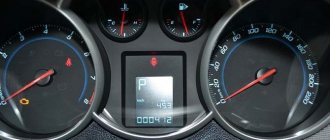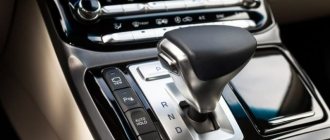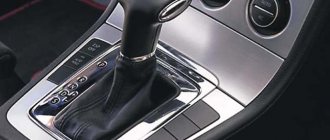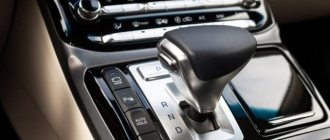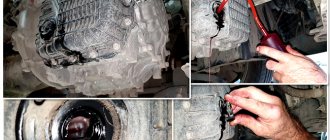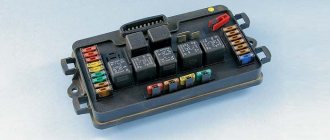At some point you realized that the gearbox does not change gears, we will try to figure out the reason. The complex device does not allow you to immediately understand why the automatic transmission does not change gears. The reasons can determine the signs that reflect the behavior of the machine. The most correct and common cause of gearbox failure was the driver. Unprofessional use of the car leads to the fact that sooner or later something breaks. The car has become in demand and useful, not everyone will climb under the hood to check the degree of wear of a particular part in order to prevent breakdown before it occurs.
Lack of transmission fluid
Let's take a closer look at several problems that arise when there is a lack of transmission fluid.
- The car does not move and a jolt is felt when the lever is shifted. The main reasons lie in low oil level. The situation can only be corrected by replenishing fluid, perhaps even cleaning the canals.
- The automatic transmission does not change gears when going uphill, the gear is downgraded, and the car starts slipping. The higher mode does not turn on. Low fluid levels reduce the vehicle's performance. At the same time, it is worth paying attention to the components (seals, couplings, cuffs) - their condition and degree of wear are significantly reflected in gear shifting. More often than not, the only solution is to change the oil and add fluid.
- Clutch slipping when changing the position of the lever on the gearbox indicates problems in the valve body; the reasons may also be hidden in the filter. In this case, it is worth assessing the fluid level and cleaning the filters.
If the automatic transmission does not change gears, the car is constantly slipping, the oil turns into foam with a change in color, then it is worth checking for the presence of water in the gearbox. Liquid ingress negatively affects the functionality of the automatic transmission and foam forms. The second reason why gears do not change when the car behaves like this is clogging of the valve body valves. The technicians will help you disassemble the mechanism and check how the pumps attached to the block work.
Accelerated adaptation
The category of accelerated process includes forced “training” of the automatic transmission, which can be performed in two ways.
In each of them, it is necessary to have a clear algorithm of actions and professionalism at hand.
Judging by the information on forums and special websites, not all car owners manage to find the necessary information themselves and achieve the optimal result.
Features of accelerated adaptation methods:
- First. The ECU is being flashed. The work must be done by specialists at a service station using special instruments and equipment.
- Second. In this case, it is necessary to train the electronic control unit in motion from scratch. To do this, detailed information and instructions for performing the work should be at hand. For each model, individual steps are provided for heating the engine, turning off and turning on the ignition, reaching a certain speed, distance traveled and braking features.
We will talk about some car models below.
Friction disc wear
When changing gear into an automatic transmission from reverse gear, the car begins to slip. The reasons for the machine's behavior are hidden in:
- displacement or deformation of friction discs;
- rupture of rings or couplings;
- valve sticking.
Disc wear can also affect the performance of the transmission. For example, it is impossible to switch to reverse gear, while at the same time moving forward is only possible in second. The reason for this behavior of the car lies in the wear of components; rubber parts are easily worn out when driving. If, during visual diagnostics, all of the specified parts are intact, then further attention should be paid to the clutch drum; perhaps the reason lies there.
You won't be able to drive a car when it's cold. If, when warming up, the car slips at forward and reverse speeds, then you should pay attention to the properties of the oil used, and if possible, it should be replaced. In addition, there may be another reason for this behavior of the car - a clogged filter.
When starting to move, the car slips in place, the movement itself continues, the speed switches perfectly. This may also indicate wear on the friction discs. In this situation, attention should be paid, among other things, to the condition of the torque converter (hub wear is possible) and to the piston cuffs.
How the adaptation algorithm works
The principle of the adaptation algorithm is that it is initially configured to interact with transmission lubricant, which has factory properties, as well as with a fully operational transmission.
When the characteristics of the oil deteriorate and parts wear out on modern automatic transmissions, the operation of the latter is adjusted. We wrote about this above.
After a major overhaul of the box, or after filling in new lubricant, the manufacturer provides for forced settings by erasing the data to factory settings.
If this is not done, the control unit will function with the old settings, based on the previous state of the lubrication and transmission.
As a result, the system will adjust the operation of the solenoids, which, when closing/opening, will move with a delay to equalize the pressure.
The gearbox does not respond to shifting
The hardest thing is when not a single gear shifts completely in the gearbox, either in automatic or manual modes, and there is no push that accompanies the switching. There may be several reasons for this behavior of the car:
- valve body malfunction;
- lack of transmission fluid;
- breakdown of the pump drive gear;
- gear shift valve sticking;
- brake band wear;
- wear of friction discs.
Actions of motorists
I’m moving on to the most anticipated part - if you are not able to figure out on your own why the gear shift on your gearbox does not engage, then you should contact a car service center, where specialists will carry out diagnostics and educate you about the breakdown, cost and repair time. Checking the functionality of automatic gearboxes is carried out only using computer diagnostics, so you should make sure that the service is available at the car service center.
If after diagnostics no faults are found, and the car continues to act up when changing gears, then you should pay attention to the speed sensors, wiring and scenes.
The backstage can be cleaned quite easily using a hole in the garage or an overpass. The gear and speed sensor is a rather capricious thing. If there is a breakdown, the sensor stops sending signals, which forces the gearbox not to respond to the signals (the gearbox simply sees that there were no signals).
If all the presented methods for eliminating the breakdown are not effective, then the car requires the intervention of a car service guru.
It is worth understanding that there are many more causes of failure, symptoms and methods for eliminating them. You should not delay resolving the issue and allow your car to “cure.”
The box has a rather complex structure, and it is impossible to answer this question right away. But based on some indirect signs, you can determine the essence of the problem and try to fix it yourself.
Problems associated with a lack of transmission fluid
1. When you move the shift lever to any of the positions, a push is felt, but the car does not move either forward or backward. A low oil level can occur due to leaks, a faulty torque converter, or a dirty oil filter. Treatment methods are obvious: replace, fix, clean. And be sure to add fluid to the level.
2. On an automatic transmission, gear shifting in the highest mode during a long climb causes slippage and a premature transition to a lower gear. This occurs because insufficient fluid level reduces hydraulic forces. The cause may also be wear of the clutch discs, wear of the cuffs or o-rings. Replacement and topping up help solve the problem.
What you can do with your own hands
There are a number of simple actions that can prevent the automatic transmission from stalling.
| Reasons why the transmission delays the transition between stages | Troubleshooting Methods |
| Automatic transmission overheating | Lack of transmission oil level, heavy loads on the automatic transmission; |
| Wear and destruction of internal mechanisms | Clean the magnet, change filters; |
| Sensor malfunction | Replace them, preferably with original ones |
Servicing a car when the automatic transmission is delayed in transmission does not always mean many problems. Some automatic transmissions are capable of exceeding the 500 thousand km mark without major repairs. To check the transmission for gear drag, it is recommended to turn on the kickdown mode. Its name describes the moment itself: push down.
If, while driving a car with automatic transmission, you sharply press the gas pedal, the car goes to a lower gear so that the speed increases as quickly as possible. If this moment passes quickly and without interruptions, then the box does not delay transitions and is in good working order.
Read
Types of automatic transmission blockers
The simplest actions that any car enthusiast can perform for his favorite iron horse when tightening is to change the oil filter and the “transmission” itself in the automatic transmission. But you need to buy consumables in trusted places so as not to stumble upon a fake.
Problems associated with friction disc wear
• Reverse gear on an automatic transmission is engaged without any complaints, and when the lever is switched to forward, the car slips in place. In addition to wear of the friction discs, breakage of the cuff or breakage of the direct clutch rings, the problem may be a stuck valve in the valve body.
• Move forward only at speed no higher than second, there is no backward movement. Disc wear affects. The problem may also be a breakage (wear) of the piston seals or breakage (wear) of the clutch oil sealing rings. If everything is in order here, pay attention to the clutch drum: the spline joint may be cut off or otherwise damaged.
• After the oil warms up, slipping is observed when moving both forward and backward. This phenomenon occurs when the viscosity of the oil decreases when heated, and the worn discs are not pressed so tightly against each other. Friction dust, a product of disc wear, may also be the cause. It clogs the filter mesh, causing the main pressure to drop.
Other main problems why the automatic transmission does not change gears
• There are no problems when moving forward, and there is no backward movement. Pay attention to the brake band. It may be worn out, the rod may be broken, or the piston collar may be torn (worn out).
• The car does not move forward or backward, and when the lever is switched from “N” or “P” to any position, there is no characteristic push. There may be several reasons for this phenomenon. In addition to a malfunction of the torque converter or a lack of transmission fluid, the drive gear of the oil pump may be broken, the first gear valve may be stuck, or the brake band or friction discs may be worn out.
It would take a very long time to list the main faults with automatic transmission speed switching, the unit is very complex. But the main problems have been voiced. And if the breakdown is more serious than indicated, then you cannot do without visiting a car service center.
Incorrect operation of the automatic transmission shifting speeds Video
Currently, a large number of cars are produced with an automatic transmission. Such a box is reliable and durable, but any mechanism can fail if it is not used correctly.
Today there are three types of automatic transmissions: “classic” automatic transmission, continuously variable variator and robotic mechanics, with the first option being the most common. Next, we will look at the main causes of breakdowns and malfunctions in the hydromechanical automatic transmission.
Read in this article
Which automatic transmissions undergo adaptation?
Unlike older cars produced before the early 1990s, modern cars are equipped with adaptive automatic transmissions that analyze the situation and adjust themselves to suit your driving style.
As a result, it is possible to reduce the number of gear changes, reduce the impact of jerks and increase driving safety.
The essence of adaptation is to record data in different load ranges in the memory of the transmission control unit (electronic unit).
To record information, speeds are switched multiple times, followed by analysis of the difference in rotation of the input-output shafts and selection of the optimal position, followed by its recording in memory.
Electronic control unit for automatic transmission Ford Focus 3
Automatic transmission does not change gears: reasons
Depending on the brand and manufacturer, automatic transmissions may have some differences, but the main causes of shifting problems are common. Let's start with the fact that the most common mistake leading to automatic transmission failure is turning on the drive mode “D” without stopping when moving in reverse. The same can be said about engaging “R” when driving forward.
You need to understand that “neutral” is a mode that unlocks the wheels for the possibility of short-term towing or moving the car in the event of some kind of malfunction. For an automatic transmission, there is no need to use it during everyday use of the car, as this causes increased wear.

